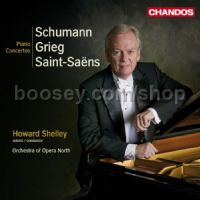Piano Concertos (Chandos Audio CD)
Piano Concertos (Chandos Audio CD)
Special Offer
* Estimated price converted from UK retail price
Edvard Grieg (1843-1907)
Robert Schumann (1810-1856)
Camille Saint-Saëns (1835-1921)
Piano Concertos
Howard Shelley (piano and conductor)
Orchestra of Opera North
Recently awarded an OBE for his service to music, March’s Disc of the Month sees Howard Shelley conduct the Opera North Orchestra from the piano.
In this latest recording Howard Shelley turns his attention to three popular works of the piano repertoire: Robert Schumann’s only completed Piano Concerto, Grieg’s single Piano Concerto and Saint-Saens Piano Concerto No.2 in G minor. This authorative disc sheds new light on these well-loved works and is the first time all three piano concertos have been made available on one disc.
Shelley explains the reasons behind the new elucidations. ‘Ever since I first fell in love with the Schumann Piano Concerto in my early teens, I have been intrigued and slightly puzzled by the tradition of slowing the fourth bar of the Allegro affettuoso first movement to what is effectively no more than an Andante, even though there is no indication of any tempo shift in the score. A metronome marking of 84 to the minim, taken from Schumann’s manuscript, is given in almost all editions of this work, reducing only to 72 to the dotted minim for the central Andante expressivo section. These are extraordinarily fast basic tempos. There are similar issues in the second movement of the Schumann – a surprisingly fast metronome mark, suggesting perhaps a lighter lyricism than we are sometimes used to, especially in the big cello melody - and also in the first movement of the Saint-Seans Second Conceto, which is often taken at about half its marked speed. As for the Grieg Concerto, we are fortunate to have Percy Grainger’s very informative and detailed notes on this piece as he discussed it with the composer. Elsewhere he points out that Grieg’s tempos were generally faster than when others played the piece. These are some of the considerations which have led to the interpretations on this recording. Directing a highly responsive orchestra from the keyboard has also allowed me great freedom in realising my ideas.’




